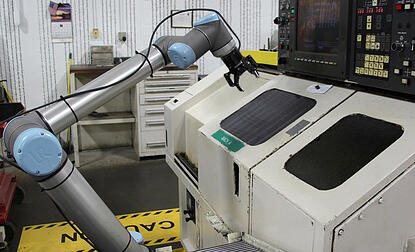How to Integrate Your First Robot (Part 2/3 Lack of Skill)

Posted on Jul 29, 2015 in Robots
4 min read time
To continue our blog post series on how to integrate your first robotic cell in your workshop, we first recommend that you read the first part of this series. The DTI (Danish Technological Institute) has identified three major causes for the gap among manufacturers concerning their use of automation, the second reason that they identify and that will be discussed in this blog post is the lack of skills.
The ''We don't have anyone that knows anything about robotics'' concept is now part of the past. With new tools and ways to learn about robotics, it is no longer an excuse to say that you don't have a background in robotics. There are hundreds of videos and testimonials from people that didn't know anything about robotics and have integrated robots in their workshop.
Lack of Skills
1. Analysis
You first need to assess your process to see what your needs are. If you are simply looking for a machine tending application or pick and place, you can use a collaborative robot that requires little to no skill. In fact, collaborative robots are designed to work alongside humans and still be safe. They are also designed to be programmed by hand guiding which simplifies the programming tasks. The interface is easier to understand and even non-technical workers can learn it. Companies, such as Universal Robots, offer a lot of videos that explain the different applications that can be accomplished by using their robot. You may want to take a look to have a better ideas of the possibilities.

However, if you are going to use robots for more specialized processes such as painting or heavy weight robotics, you may want to contact someone that already has experience with robots. These robots are slightly more complicated to automate and need more in depth knowledge. Call your local integrator and ask for an initial analysis of your process.
2. Educate, hire, consult!
After completing a process analysis, you need to decide on how you want to robotize your task. As I said in the first part of this series you need to dedicate someone to the project. However, this person does not necessarily have to have a robotic background. This is why you should provide this employee with training. The advantage of doing this is that the worker who is working daily in the shop has a better idea of what can or cannot be automated.
You can also hire a robotic specialist or a robot programmer depending on your robot cell complexity. This can bring a different set of skills to the team.
Finally you can literally give everything to an external firm, give them a checklist of what should be done and what are your ''nice to have'' features. Doing it this way is probably more expensive than doing it in-house and the knowledge does not remain in the company. But, it is definitely the fastest way to do it. It all depends on your priorities. Just remember the old English proverb: give a man a fish and you feed him for a day; show him how to fish and you feed him for a lifetime.3. Involve everybody
 The key to robot integration is to involve everybody. All levels of the enterprise should be involved in the integration process, from direction to floor worker. If you try to integrate a robot without your employees’ participation, the first thing you will notice is that the employees will be against it. If you involve them in the process and ask their opinion, you will see a better acceptance and integration of the robot. You may want to take a look at this document that explains how to integrate a collaborative robot in a global company. This will explain the roles for the different levels of the enterprise when implementing a first robot.
The key to robot integration is to involve everybody. All levels of the enterprise should be involved in the integration process, from direction to floor worker. If you try to integrate a robot without your employees’ participation, the first thing you will notice is that the employees will be against it. If you involve them in the process and ask their opinion, you will see a better acceptance and integration of the robot. You may want to take a look at this document that explains how to integrate a collaborative robot in a global company. This will explain the roles for the different levels of the enterprise when implementing a first robot.
4. Select your supplier
As you have probably notice with your own supply chain, you may want to keep your suppliers close to you and build a good relationship with them. It is the same thing with automation, if you are going to use robots, you want to use the same brand (as much as possible) to build a knowledge in this brand. Aside from programming methods, integration will be easier as you develop more expertise with a robot brand. In addition to all this, your supplier will know your needs and what the best options are for your next robotic cell. Also it will make maintenance easier, too.
5. Share and develop knowledge
Participate in network, meetings and publish your application(s) on social networks. This will spread the word and potentially give some ideas to other people, who like yourself need ideas for their robotic cell. You should also try to stay up to date in the latest programming methods, software updates and new tool models. This will give you a better overall look at the situation and will allow you to see if your actual process can be enhanced or if you can enhance another process in your workshop. Most of all don’t worry if you don’t have this expertise at the moment, the next blog post will talk about lack of technology and how you can build up this expertise.
Related Articles







Leave a comment